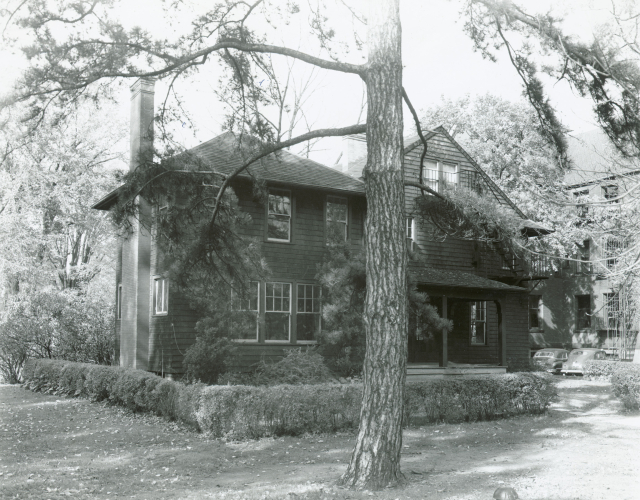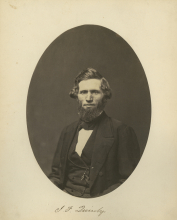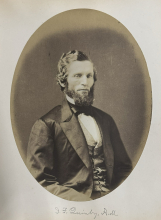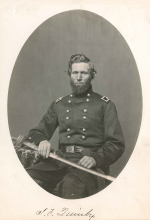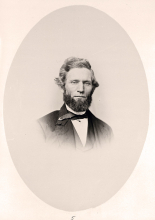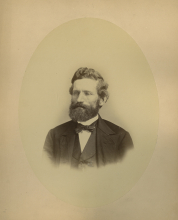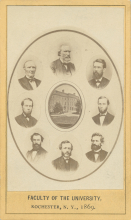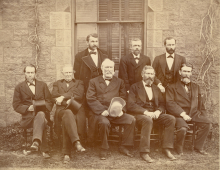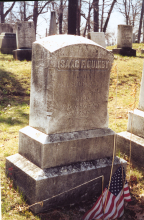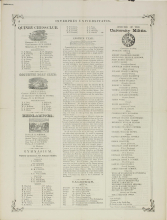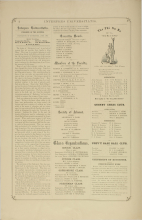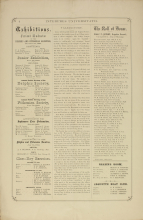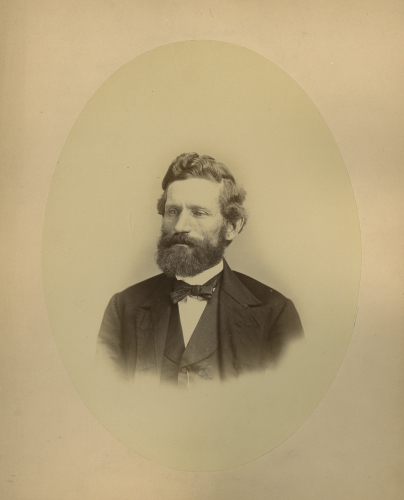
The Ask the Archivist column in the Fall 2023 Rochester Review could only scratch the surface of Professor Adam Frank's question about who Professor Isaac Quinby was and the many roles he played in Rochester and beyond. You can read the article here.
Below are photographs of Professor Quinby, a selection of reminiscences, and the text of his obituary in the Rochester Morning Herald.
Letters to and from Professor Quinby may be viewed here. Please consider helping to transcribe the letters! You'll find a guide to using the transcription editor here.
The circumstances which led to Quinby's resignation are unclear, but his letter of resignation was submitted on August 1 of that year. The document in the Archives, includes another paragraph on the page: a pledge to abstain from alcohol. Quinby was not the only faculty member who would make such a pledge during this era. He requested that he would receive a full year's salary after his resignation, and that it be paid to his wife Elizabeth, to whom he gave full control of the family finances and property.
_________________________________________________
There are many photographic portraits of Professor Quinby in the University Archives, made to accompany the senior class photo albums (the Interpres yearbooks did not have photographs until the 1890s)
_________________________________________________
Quinby was fondly recalled by his students, and his family (some of whom were also Rochester alumni). His grandson H. Dean Quinby (Class of 1918) recalled his grandfather for the Rochester Review, which inspired a letter from Charles Wood (Class of 1864).
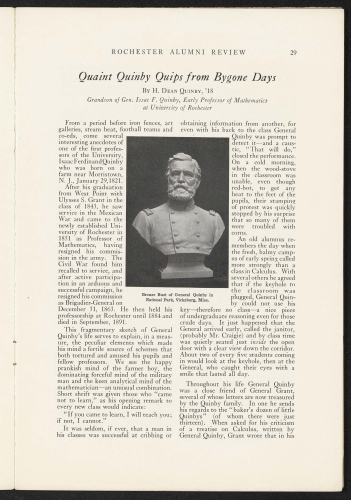
_________________________________________________
Pages from the Interpres yearbooks showing members of the Quinby Chess Club, and the Civil War Honor Roll (see more)
_________________________________________________
This obituary from the Rochester Morning Herald, September 19, 1891, is a longer version of the profile written by Professor Asahel C. Kendrick for the Class of 1884 Interpres. (Note that the 1884 yearbook was published in 1883, in keeping with the tradition that it be produced in the Junior year of the class.
General Quinby was born at Halseytown, Morris County, New Jersey, January 29, 1821. His early education was acquired in the country school of that place supplemented by private education by a Princeton tutor. In 1837 he began the study of medicine but abandoned the medical profession for the army upon receiving in 1839 an appointment to West Point., where he graduated in 1843, being a classmate of Ulysses S. Grant. His course in this institution was a very successful one, and he led his class in engineering. He became acting professor of mathematics and natural philosophy at West Point in 1844 and continued in this capacity for three years, leaving the academy in June, 1847 to conduct a body of recruits to the various posts of General Taylor's army on the line of the Rio Grande. On the completion of this duty he was assigned as first lieutenant to Bragg's battery, and in January, 1848 returned to Fort Columbus, New York. From here in the following March he sailed for Vera Cruz with recruits for the army of General Scott and took part in the closing campaigns of the Mexican War.
At the close of that war, Lieutenant Quinby was ordered with his company--L, 3rd Artillery--first to Fort Monroe, Virginia, and then to Fort Adams, Rhode Island. From November 1, 1848, he acted as regimental quartermaster for about a year, when he became adjutant of his regiment, a position which he held till September, 1851, when he resigned his commission to accept the professorship of mathematics and natural philosophy in the University of Rochester. Here, for a period of ten years, Professor Quinby fulfilled the duties devolving upon him in such a manner as to win the high esteem of his associates and the students for his scholarly attainments.
The breaking out of the rebellion recalled the soldier to the duties of the field and in May of 1861 he led the famous 13th New York volunteers to the front. He remained with the regiment as its colonel through the Bull Run campaign, resuming his chair in the University after the three months for which his regiment enrolled. In March, 1862, he was commissioned brigadier-general of volunteers and assigned to duty at Columbus, Kentucky, with instructions to construct batteries to prevent rebel gunboats from ascending the Mississippi and Ohio rivers. In October 1862, he was ordered to command of a division in the army of the Tennessee under General Grant, and remained with that army throughout the Mississippi campaign until the last assault on Vicksburg, May 22, 1863. In the spring of 1863, General Quinby was ordered with his division to the command of the Yazoo Pass expedition. In June, 1863, he was ordered home on sick leave, and in the following July took charge of recruiting station at Elmira, serving in this capacity until the fall of 1864, when he was appointed provost marshal for the 28th Congressional district.
At the close of the Civil War, General Quinby returned to his chair in the University of Rochester; but during the eight years of President Grant's administration, he was relieved of a portion of his college duties, and held the office of United States Marshal for the northern district of New York. He resigned his professorship in 1884. He was a trustee of the Soldiers' Home in Bath and vice-president of the board from the foundation of the institution in 1879 till his resignation in 1886. In addition to his official duties he was frequently employed as consulting engineer, He revised and rewrote several works on the Robinson course of mathematics and the treatise on the "Differential and Integral Calculus" in that series is altogether his.
In the spring of 1886, General Quinby was elected by the common council as city supervisor, and in 1888 he was re-elected for another term of two years. After his retirement from his office he ceased to take part in public affairs.
General Quinby was honored by degrees from two institutions of learning. He received the degree of A. M. from the University of Rochester and Hobart College in1852 and that of LL.D. from Hobart College in 1869. He was an honorary member of the local chapter of the Psi Upsilon fraternity.
General Quinby married Elizabeth G. Gardner, daughter of General John L. Gardner of the 4th artillery, at Old Point Comfort, Virginia, October 6, 1848. Thirteen children were the result of this union, eight of whom are still living.
His death removes the second of the three famous educators who during the first quarter century of the University of Rochester were mainsprings of its existence—Martin B. Anderson, Asahel C. Kendrick, and Isaac F. Quinby—affectionately known among two generations of students as "Prexy," "Kai Gar," and "Quin." And of these three none was more popular among the boys than "Quin." He was beloved as much as the calculus which he taught was detested. That old classroom in Anderson Hall was remembered by every alumnus as "Quin's room" was generally a perfect bear garden as far as behavior was concerned, but it was a place where men were sure to get found out who assumed to know what they had not learned. The professor had an ill-concealed contempt for blockheads and would often convulse the class with laughter at his sarcastic remarks while endeavoring to make a dull boy see the point of a demonstration. "Cribs" were useless in his room, for the unlucky wight who used one was always sure to get tripped up when he came to demonstrate his work and be compelled to sit down in great discomfiture. The General had a habit of sitting with his back turned to the blackboard while a student was giving a demonstration, but so acute was his perception that he never failed to detect an error, either in the process or the result. His talks to the boys were characterized by a dry humor that was one of the most exquisite spices of college life, and many of his sayings have become proverbs.
[end of obituary]
_________________________________________________
While the grandson and great-grandson of Professor Quinby attended the University, of the 13 Quinby children only Lois attended the University. She was one of about a dozen young women who took classes as special students between 1875 and 1900, during the time before women were admitted as undergraduates.
_________________________________________________
Like several other early faculty, Professor Quinby and his family built a home on the campus of the University on its Prince Street Campus. Quinby foresaw the usefulness of owning this property, and the likelihood that the University would want to purchase it at a future date. The house, located at 44 Prince Street, eventually would serve as office space for the University administration; as a faculty club for the College for Women; as home for the Memorial Art Gallery's Creative Workshop; and then as office space during the 1966 expansion of the Gallery. It was razed in 1970.
